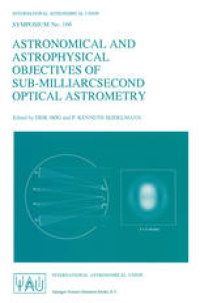
Ebook: Astronomical and Astrophysical Objectives of Sub-Milliarcsecond Optical Astrometry: Proceedings of the 166th Symposium of the International Astronomical Union, Held in the Hague, The Netherlands, August 15–19, 1994
- Tags: Astronomy Observations and Techniques
- Series: International Astronomical Union / Union Astronomique Internationale 166
- Year: 1995
- Publisher: Springer Netherlands
- Edition: 1
- Language: English
- pdf
Astrometry is on the threshold of great changes due to the fact that this decade, alone, is witnessing an improvement of stellar positions equivalent to the total improvement of the previous two centuries. The Hipparcos Satellite has concluded its observations, and the catalog is in preparation. Preliminary results assure that the Hipparcos catalog will provide positions, parallaxes and annual proper motions for over 100,000 stars with accuracies of 1.5 milliarcseconds. In addition, the Tycho catalog will provide positions of about 30 milliarcseconds accuracy for over 1 million stars, and annual proper motions with 3 milliarcsecond accuracy will subsequently be ob tained by means of first epoch positions from the Astrographic Catalog. Optical interferometers on the ground are beginning operation, and these instruments can provide observational accuracies of approximately one milliarcsecond. Also, the traditional reference frame based on the Fun damental Catalog of bright stars is being replaced by the extragalactic ref erence frame, based on radio sources with accuracies of one milliarcsecond. Thus, astrometry will change from a fundamental reference frame defined in terms of the dynamical reference frame of the solar system with accuracies of 100 milliarcseconds to a space-fixed, extragalactic reference frame with accuracies of one milliarcsecond. Future astrometric observations should be in the 1 -100 milliarcsecond accuracy range. There are a number of concepts for future astrometric instruments in space. Most of these can provide sub-milliarcsecond astrometric accuracies.
Astronomical and Astrophysical Objectives of Sub-Milliarcsecond Optical Astrometry contains a series of papers that discuss the major changes occurring in modern astrometry. The results of space missions in astrometry, Hipparcos and some results from the Hubble Space telescope are presented for the first time. Combined with ground based results, this provides astrometry results at milliarcsecond resolution. At the same time, the extragalactic reference frame, based on very long baseline interferometry radio positions, is being introduced as the fundamental reference frame. It is now also evident that future optical interferometry space missions can provide an additional improvement in future of orders of magnitude. In addition to presenting the results, the book also discusses different applications based on such accurate astrometric positions.
This startling improvement in resolution will encourage all astronomers to consider what can be done in future, providing a great stimulus to forthcoming research.